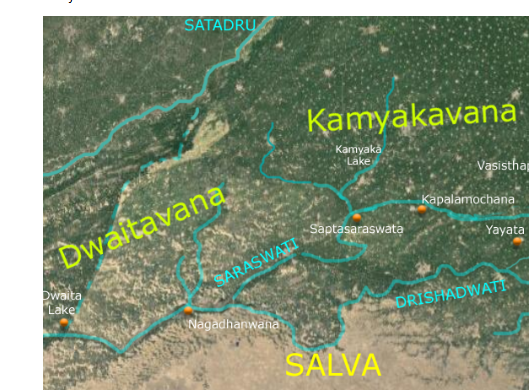Yamuna: A Study of Its Links from the Sarasvati Findings- II
[contextly_sidebar id=”vdoLuzMmuuGmD5H3H2umRp1R8M1rhnN1″]
In the last part, we dealt with Yamuna Saraswati Drainage links and the Kuru territory and its connection to the Yamuna. Let us now look into Balarama’s journey along Saraswati.
Balarama’s Travel along Sarasvati leading to the Source of Yamuna
Balarama’s pilgrimage tracing the Saraswati River from its confluence with Western Ocean to its source in the lower Himalayas is detailed in the Shalya Parva of Mahabharata in chapters 33 to 52. Balarama follows the trail of Saraswati and finds its middle part lost in the desert, exactly where now lies the Thar Desert.
List of Places Visited by Balarama
| 1 | Dwaraka | 18 | Vasishthapavaha |
| 2 | Prabhasa | 19 | Aruna |
| 3 | Chamasodbheda | 20 | Soma |
| 4 | Udapana | 21 | Taijasa |
| 5 | Vinasana | 22 | Agnitirtha |
| 6 | Subhumika | 23 | Brahmayoni |
| 7 | Gandarva Tirtha | 24 | Kauvera |
| 8 | Gargasrota | 25 | Vadarapachana |
| 9 | Sankha | 26 | Sakta |
| 10 | Dwaita | 27 | Indra-tirtha |
| 11 | Nagadhanwana | 28 | Rama |
| 12 | Sapta-Saraswat | 29 | Yamuna |
| 13 | Usanas | 30 | Aditya |
| 14 | Asylum of Rushangu | 31 | Sarasvata |
| 15 | Lokaloka Mt. | 32 | Samantapanchaka |
| 16 | Asylum of Vaka | 33 | Plakshaprasravana |
| 17 | Yayata | 34 | Karavapana |
| 35 | Mitra-Varuna (at Yamuna) |
Table 1: The places mentioned in the Balarama’s journey along the Saraswati River (mbh.9.33-52)
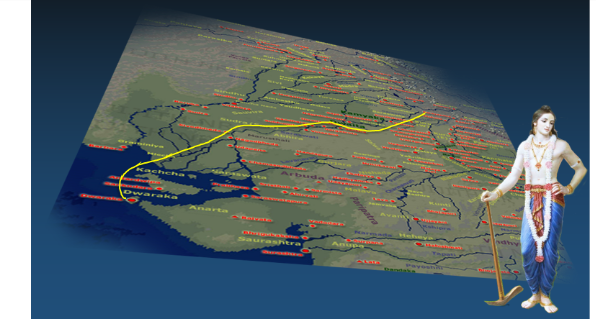
Image 1: An illustration of Balarama’s journey along the Saraswati River with the approximate path shown as a yellow curve. Shorelines of Gujarat area are approximations based on bathymetric studies. The Saraswati drainage system indicated are approximations based on previous studies.
In subsequent sections we shall explore each place in detail, giving vital clues about the course of the river, the different turns it makes and the different terrains through which it passes through, like deserts, wetlands, forests, lakes and highly populated areas.
Dwaraka
Balarama starts the journey under the constellation of Pushya (mbh.9.33). The items carried for the travel mentions horses, elephants, mules and camels. The presence of camels in this list indicates travel through deserts and arid lands. Elephants indicates travel through forests and green lands. A partially dried up Sarasvati is thus indicated in the very beginning of the journey itself.
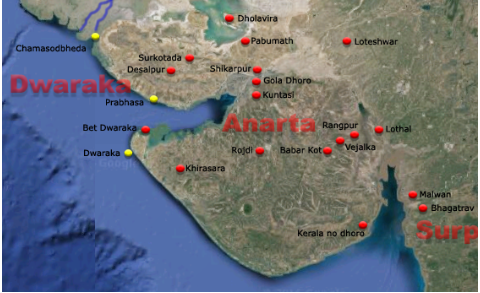
Image 2: Excavated sites in Gujarat Region with the probable location of Dwaraka, Prabhasa and Chamasodbheda
Prabhasa
The narration of the journey through Prabhasa, touches upon topics like the cure for the disease of phthisis incurred by Soma. This symbolically indicates the decline of the Soma-cult and Soma-plant cultivation in the Sarasvati river valley. Wasting of Soma due to disease is indicated by mentioning that the creepers & herbs too failed to grow, juices dried up and it became tasteless. (mbh.9.33). Living creatures began to decay. Soma rejuvenated in the Western Ocean coast where Sarasvati merges with ocean. This implies that the Soma-cult and Soma-plant cultivation from the dried up regions of Sarasvati got re-established in the Prabhasa region where Sarasvati merged with the Western Ocean viz. in the Somnath, Dwaraka & Rann of Kutch of Gujarat (India) and the southern Sindh (Pakistan).
In the Mahabharata, Prabhasa is mentioned as a plain: – ‘the plains of Prabhasa’ (mbh 3.12) as a region – ‘the western Prabhasa’ (Mbh 13.94) and as ‘the sacred landing-place’ on the coast of the sea (Mbh 3.119). This shows that during the time of Balarama, the name Prabhasa (also known as Prabhasa-kshetra) applied to the whole of Gujarat and Sindh sea-shore unlike today where it is identified with a place (Prabhas-patan) in the southern coast of Gujarat. The mention of Prabhasa as ‘the sacred landing place’ could indicate that it is the region where Saraswati drained in to the sea or the place where the people migrating from the ancient flooded sea-coasts had landed and got established temporarily.
Chamasodbheda
Balarama passed one night here. Chamasodbheda is mentioned along with Prabhasa as a holy spot on the sea-coast in Saurashtra region at mbh.3.88. It is also mentioned (indirectly, i.e. mentioned after Prabhasa) as the spot where the Saraswati mingles with the sea at mbh 3.82. This implies that Chamasodbheda was the exact spot in the Prabhasa Kshetra, where the Saraswati River with its over-ground and underground waters ‘broke off’ (udbheda) through the land and flowed into the sea.
Udapana
Here Saraswati is lost, but recognizable from the coolness of the herbs and land– (mbh.9.33). Saraswati here has an invisible current underground (mbh.9.33). Balarama bathed here, touched the waters here (mbh 9.34). This could be some small Saras (lake) formed due to the underground flow of Saraswati. Ascetics like Trita drank the Soma juice here (mbh 9.34). Gautama’s sons Ekata, Dwita and Trita, who were Vedic scholars, lived here. Their occupation includes performing Vedic sacrifices to earn wealth (mbh 9.34). Animals where used in the sacrifices (mbh 9.34). Woodland contained wolf (and also probably leopard, bears and apes) (mbh 9.34). Deep pits & holes with creepers found on the banks of Sarasvati, probably created due to the underground flow of the river (mbh 9.34).
All this indicates that Soma cult & cultivation, Vedic culture and Vedic sacrifices existed here. Officiators (priests) of Vedic sacrifices earned much wealth. In the absence of Soma plant, it was substituted with creepers. In the absence of Sarasvati, the presence of the river was imagined.
Vinasana
Sarasvati completely is invisible and lost here (mbh 9.35). This region was inhabited by Sudras and Abhiras (mbh.9.35), in contrast to the mention of the presence of the Brahmanas at the previous spot Udapana and the next spot Subhumika. Balarama bathed here indicating the presence of some small Saras. This place is located at Derawar Fort (Ref. History and Historians in Ancient India, By Dilip Kumar Ganguly).
Subhumika
In contrast to Vinashana, Subhumika is mentioned as a wet-land on the banks of Sarasvati (mbh.9.35) probably due to lakes in the partially dried up course of Saraswati, inhabited by fair complexioned diverse tribes of Apsaras, singing songs and musical instruments. The word Apsara etymologically means ‘those living close to a Saras (lake) or a waterbody (Apa). Tribes of Deva-Gandharvas and Rakshasas found here indicating a multi-ethnic population. Flora consists of flowering plants & creepers.
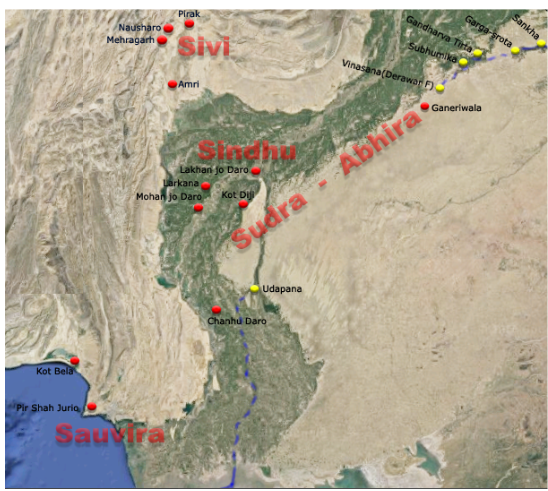
Image 3: Probable location of Udapana, Vinashana, Subhumika, Gandharva Tirtha, Gargasrota and Sankha.
Gandharva Tirtha
Gandharva tribe headed by Vishavasu is found here (mbh 9.35). Balarama gives gifts, including camel, sheep & mule to Brahmanas here, indicating that the spot lied between the desert in the south (Thar Desert) and the wetlands in the north (Dwaita, Kamyaka forests of Punjab). Anyone traveling from the northern regions to the south will require those camels, sheep and mule.
Gargasrota
Many ascetics & Brahmanas, including astronomer Garga who studied deviations of celestial objects and acquired knowledge of time, lived here (mbh.9.35)
Sankha
A big tree called Mohasankha is mentioned as present here, indicating that it was a grassland and dense forests like Dwaita was still far away in the north and east (mbh.9.35). Inhabitants of this region are described as Yakshas, Vidyadharas, Rakshasas, Pisachas and Siddhas (mbh 9.35)
Dwaita Lake
This is the famous lake in the Dwaita forest where the Pandavas lived many years of their life in their 12 yearlong exile. This region is mentioned as inhabited by Brahmanas and ascetics (mbh 9.35). From here onwards Balarama proceeded along the southern bank of Sarasvati (mbh 9.35). This indicates that the northern bank of Sarawati at this spot was part of the dense Dwaita forest. The Dwaita Lake could be a prominent lake formed in the highly visible paleo-channel emerging from Satadru to Saraswati. Kamyaka Lake is locatable in a less prominent north-eastern paleo-channel, which could be a tributary of Saraswati or a channel from Satadru. Pandavas spent the rest of their 12 yearlong forest life at Kamyaka forest containing the Kamyaka Lake.
This place is mentioned as inhabited by Nagas with Vasuki as their king installed by the Devas (mbh.9.35). This is a data-point towards my inference that the ethnicity of the population of the Saraswati-Yamuna region constituted Nagas, Purus and Yadus. This place is also mentioned as the permanent abode of many Rishis and Brahmanas (mbh.9.35). From here onwards Balarama is moving eastwards containing numerous Tirthas with permanent residence of many ascetics.
The subsequent spots mentioned in Balarama’s pilgrimage falls in the greater Kurukshetra region lying between Drishadwati and Saraswati. These spots falls in the densely populated southern banks of Saraswati.
The densely populated southern banks of Saraswati
The Tirthas on the southern banks of Sarasvati looked like towns and cities due to the settlement of ascetics migrated from Naimisha (mbh 9.35). These settlements extended up to Samantapanchaka. The region was active with Vedic sacrificial fires and Vedic recitations. Valhilyas, Asmakuttas, Dantolakhalinas, Samprakshanas and other ascetics living on air, water and dry leaves lived here. Due to high population, the Rishis failed to find space to live here (mbh 9.35). Ascetics used threads to measure small plots here. They performed Agnihotras and other diverse rites. The archaeological excavations here reveal settlements corroborating with this as they contained inhabitable plot layouts with precise measurements.
Spots where Saraswati turns eastward and then westward
It is poetically mentioned here that, as if to accommodate large population, the course of Sarasvati turned eastward and then returned to its westward flow (mbh.9.35). This indicate a notch in the course of Sarawati and it is named Sapta-saraswata in the narration. This twisted river-course is locatable from the narration near to the south-west corner of the Kurukshetra region.
Sapta-sarasvata and Migrations from Sarasvati
The flora in this region consisted of Vadar, Inguda, Ksamarya, Plaksha, Aswattha, Vibhitaka, Kakkola, Palasa, Karira, Pilu and other trees; Forests of Karushakas, Vilwas, Amratakas, Atimuktas, Kashandas and Parijatas. There were forests of plantains. There were many feathery creatures found here (mbh 9.35).
Many ascetics & Brahmanas, including astronomer Garga who studied deviations of celestial objects and acquired knowledge of time, lived here (mbh.9.35). Some Ascetics ate raw grains husked using stones, others ate fruits. Ascetic tribe named Vaneyas, chanted Vedas.
The Seven Sarasvati streams are mentioned as Suprava, Kanchanakshi, Visala, Manorama, Oghavati, Surenu and Vimalodaka (mbh 9.36). Of this only Oghavati is identified as flowing in the Kurukshetra region. Other streams are used symbolically to indicate many migrations from Saraswati to other regions like to: –
- Pushkara (Sarasvati as Suprava) – Pushkar, Rajastan
- Naimisha (as Kanchanakshi) – Naimisharan, Uttarpradesh along the Gomati River
- Gaya (as Visala) – Gaya in Bihar
- Northern Kosala (as Manorama) where reached the sages headed by Auddalaka clad in barks and deer-skins) – Mithila in Nepal, north of Bihar
- Kurukshetra (as Oghavati) where king Kuru with priest Vasistha engaged in sacrifice
- Gangotri (as Surenu) where Daksha engaged in sacrifice
- Himavat mountain (as Vimalodaka or as all streams together)
Sapta-Sarasvat is assumed as having all these 7 Tirthas together (mbh. 9.36). Here Sarasvati is mentioned as a river of swift current flowing from the sides of Himavat (mbh.9.36).
The Sapta-Sarasvat could indicate 7 minor tributaries or old channels of Sarasvati present here with the prominent channel being Oghavati (flowing through Kurukshetra). The Sapta-Sarasvat could also be a synonym of (or a name inspired by) Sapta-Sindhu (Sindhu, Vitasta, Chandrabhaga, Iravati, Satadru, Sarasvati).
Sapta-Sarasvat is mentioned as the abode of sage Mankanaka (mother Sukanya, father Marut) and the origin of 7 Rishis (Sapta-maruts) and from them 49 Maruts (mbh.9.36). Mention of vegetable juice (Soma?) and ashes white as snow (of burnt Soma plant?) is found here (mbh.9.36).
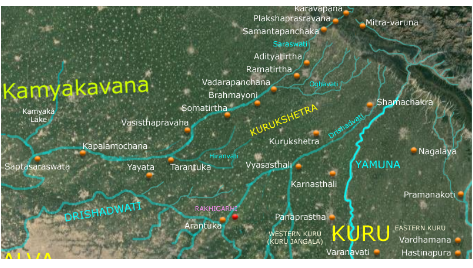
Image 5: The four cornered Kurukshetra and the holy-spots along the banks of Saraswati flowing to the north of Kurukshetra.
Usanas (Kapalamochana)
This place is mentioned as the abode of Usanas (sage Sukra) who had done penance for Daityas and Danavas. This indicate that this was a territory shared by Adityas, Daityas and Danavas who engaged in mutual conflicts here. Here there is a mentions about a skull (probably skulls of people from older settlements?). (mbh.9.37).
Asylum of Rushangu, Lokaloka Mountain and the Asylum of Vaka
This place is located in the northern banks of Saraswati. Arshtishena had done penance here (mbh 9.37). Arshtishena, Sindhudwipa, Devapi and Vishwamitra changed from Kshatriya to Brahmana here. Dalvya Vaka, who lived here had an encounter with Dhritarashtra and made his kingdom waste, loss of prosperity and life (mbh.9.39). As a result of this, large forest began to disappear when men proceeded to cut it down with axe (mbh 9.39). Finally the kingdom reclaimed its prosperity (mbh 9.39). Brihaspati had done penance for Devas against Daityas here. This indicates that this was a territory shared by Adityas, Daityas and Danavas, who engaged in mutual conflicts here.
Yayata
Yayati, the son of Nahusha had done penance here (mbh 9.39). The production of milk and clarified butter is mentioned here (mbh 9.39). These are the occupations of the Yadavas. Names like Yayata here affirms that this was indeed the place where Yayati and other Aila ancestors of the Kurus lived.
Vasishthapravaha
Here the swift current of Sarasvati is mentioned as it flows making a turn and washes away one of its bank due to the swift current (mbh 9.40). River is mentioned as turning red (probably due to the mud generated from the erosion of the banks due to swift currents), flowing thus for a whole year (mbh.9.40).
Vasishta lived on the eastern bank at Sthanu. Vishvamitra lived on the opposite bank. This place was a witness to the competition between Vasistha and Vishwamitra recorded in the Vedas and the Mahabharata.
Here the Devas installed Skanda as their Commander in Chief, indicating this as the battlefield of the Adityas, Daityas and the Danavas.
Sarasvati is here mentioned as originating from Manasa Lake, as per Visvamitra (mbh 9.40), which in retrospect should not be mistaken as Lake Manasa in Kailasa.
Presence of Rakshasas is attested here, and they found frequent mentions in the conflicts of Vasistha and Viswamitra.
Tirthas of Aruna, Soma, Taijasa and Agni
Aruna Tirtha (red holy-spot) is mentioned as a newly formed bank of Sarasvati (indicating that this spot is same as or not far from, Vasisthapravaha) (mbh 9.41). Formerly the presence of the river here was concealed, but then it suddenly got flooded (mbh 9.41).
Soma Tirtha is a place where a battle of Devas versus Daitya, Danavas and Rakshasas took place (9.41). Battle of Skanda versus Taraka also took place here (mbh 9.41). There was a gigantic Aswattha tree here where Skanda resided.
Taijasa Tirtha is the place where Varuna was installed as the king of waters by Devas- (mbh 9.44). Balarama stayed here for one night.
In Agni-tirtha, Fire concealed inside Sami wood is mentioned mbh.9.45. This was also the abode of Brihaspati and Bhrigu.
All this indicate that these places locatable on the banks of Saraswati to the north of Kurukshetra were places of co-habitation and conflicts of Aditya-Daitya-Danavas and other tribes like Rakshasas and Yakshas.
Brahma-yoni
This spot is mentioned as the seat of creation by Brahma (9.45). This is significant for the Avestan as well, because in Avestan, Brahma is represented as Spitama. Mahabharata describes the whole of Kurukshetra as Brahmavarta and considers it as the northern sacrificial altar of Brahma and of the Devas. Another name for Kuruskhetra is Ilaspada.
Kauvera
Ailavila (Kuvera, king of Yakshas) had done penance here. The name Ailavila indicates that he lived in the territory of Ila, viz. Ilaspada, i.e. Kurukshetra. The woods of Kuvera is mentioned here (mbh.9.45). Maruts installed him as the king. Kuvera obtained a son named Nalakuvera and a flying Vimana here.
Vadara-pachana
This was a place abundant with fruits (jujube) and flowers (mbh.9.45). Sruvavati, daughter of Bharadwaja, who lived here as a Brahmacharin, became spouse of Indra – mbh 9.46. Here, there is a mention about a 12 year long drought connected to Saptarshis and Arundhati (constellation shift due to precession?) (mbh.9.46)
Tirthas of Indra, Rama, Varuna (Yamuna) and Aditya
Indra had done 100 Ashvamedhas at Indra-Tirtha.
Parasurama did hundred Ashvamedhas and Vajapeya at Rama-tirtha with Kasyapa as the priest. Balarama gave kine, elephants, sheep and goat here (mbh.9.47).
At Varuna Tirtha (also called Yamuna-Tirtha), Varuna had done Rajasuya. Here there is an indication that a channel of Yamuna may be entering Saraswati at this spot. But this is not provable as data is too sparse to make any conclusion regarding this. Varuna battled against Manavas, Devas, Gandharvas and Rakshasas here. A Battle between Devas (Adityas) and Danavas occurred here (mbh.9.47).
At Aditya-tirtha, Aditya performed penances. Vyasa, Suka and Asita-Devala are mentioned here. Adityas like Indra and Vishnu, Viswadevas, Maruts, Gandharvas, Apsaras, Yakshas, Rakshasas and Pisachas are mentioned here. Vyasa and Devala attained Yoga powers doing Yoga here (mbh.9.47).
Asylum of sage Sarasvata
Sage Saraswata taught the lost Vedas during the 12 year drought here (mbh 9.49). Dadhica and Apasara Alambusa are mentioned here. Their son was Sarasvata. Dadhica gave his bones to Indra to make Vajra here. In a spot close to this place, Kuni-Garga’s daughter and Galava’s son Sringavat lived together for one night (mbh 9.50). Balarama hears about the death of Shalya here.
Samanta-panchaka
It is mentioned as the eternal northern sacrificial altar of Brahman (mbh 9.51). King Kuru had cultivated and tilled the soil of the field for many years and hence is called Kurukshetra (mbh 9.51). Kuru was helped by Indra here to prepare the land. King Nriga had performed penance here. Here it is mentioned that the space between Tarantkuka, Arantuka and the lakes of Rama (Samanta-panchaka) and Shamachakra is Kurukshetra
Plaksha-prasravana
Balarama continues his journey eager to see the source of Saraswati and proceeds beyond the boundaries of Kurukshetra at Samantapanchaka and reached Plaksha-prasravana by slightly ascending the Shivalik (lower Himalayan) hills. Here the flora is described as consisting of Madhuka, Mango trees, Plaksha, Nyagrodhas, Vilvas, Jack tree, Arjuna trees (mbh 9.52). Vishnu performed penances here. A Brahmin maiden Sandilya is mentioned as living here. To arrive at this hermitage Balarama reached the foot-hills of Himalayas and ascended the mountain (mbh 9.52). The narration gives this spot as the source of Sarasvati emerging from the Shivaliks, and close to the sources of Yamuna.
Karavapana
Proceeding a little further he reached Karavapana. Balarama stayed here for one night (mbh 9.52). This is the last spot mentioned as on the banks of Saraswati in Balarama’s journey, since Balarama’s final destination, viz. the Asylum of Mitra-Varuna was on the banks of Yamuna. This is probably the spot where Saraswati becomes a recognizable stream by collecting many rain-fed streamlets in the Shivaliks. The narration gives this spot as located a little higher in the Shivaliks than the Plaksha-prasravana, which is probably located at the foothills of the Shivaliks where the hills merge with the plains.
Asylum of Mitra-Varuna at Yamuna
This spot is mentioned as located on the banks of Yamuna (mbh 9.52). This make it clear that the source of Saravati was not far away from Yamuna. Indra, Agni and Aryaman is mentioned here. Here Balarama hears more about the status of Kurukshetra war from Narada and returns to Samanta-Panchaka. He descended to Plaksha-prasravana and from there back to Samanta-panchaka and joined Krishna and Pandavas there.
In the next concluding part, we would deal with various issues like IE Dispersal from Yamuna-Saraswati Region, Yamuna-Saraswati Ethnicity, and many other related topics.
Featured Image Credit: https://www.oyorooms.com/blog/a-weekend-trip-from-delhi-to-agra/


